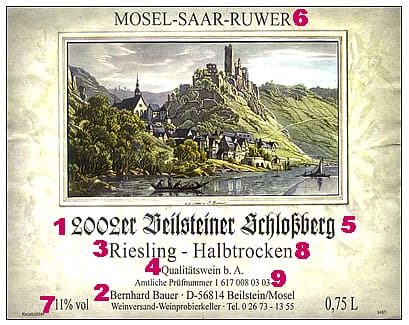Noted Mosel Valley
Riesling Wine ProducersTop Estate Wineries
(generally available in America)
Reinhold Haart — Piesport
Selbach-Oster — Zeltingen
Joh. Jos. Christoffel — Ürzig
Fritz Haag — Brauneberg
Dr. H Thanisch — Bernkastel
Dr. Frisher — Ockfen / Saar
C. von Schubert — Mertesdodrf / Ruwer
Dr. Loosen — Bernkastel
Joh. Jos. Prüm — Bernkastel
Dr. Pauly-Bergweiler — Bernkastel
Dr. F. Weins Prüm — Bernkastel
S A Prüm — Bernkastel
Studert-Prüm — Bernkastel
|
“Beverage” Wines
Many of these wines are marketed as Riesling Piesporter from various vineyards
(like Michelsberg and Goldtrophfchen) and various ripeness levels (like Spatlese)
and various qualities (like Qualitätswein & QmP.) Generally, these wines do
not hold the distinctive attributes of “Estate Wines,” but often serve as
good general purpose table wines.
Carl Graff Piesporter Goldtropfchen Riesling Spatlese
Schmitt Söhne Riesling Spätlese Qmp (Blue Bottle)
Deinhard Piesporter
Leonard Kreusch Michelsberg Piesporter
Jakob Demmer Piesporter Micheslberg
|
Mass Market
One major downfall in the Mosel Wine industry is that many of the wines marketed
in the United States capitalize on “selling a product” instead of “celebrated
quality.” Many of these mass produced wines are made with the help of every
legally allowed trick one can think of. Grapes from many of the leaser vineyards
are often mixed with castoffs from better vineyards, then manipulated with added
sugar and “sweet-reserve” to produce a palatable wine with little of the
fine characteristics found in estate wines. Using names from the famous wine
villages like Zeller Schwarze Katz, or Kröver Nacktarsch, these wines flood the
general market for German wines. To further complicate this issue, vineyard
names such as the fictional Piesporter Michelsberg are easily confused with the
highly celebrated Piesporter Goldtröpfchen. |
German
Wine Labels
Many people are confused or put off by the amount of information on German
labels. There is a lot that German label tell the consumer.
- The Vintage The year when the grapes were grown - not necessarily when they
were harvested - is indicated. Eiswein is sometimes harvested as late as in
January of the following year. Again, only 85% must actually be from the
vintage, creating a loophole for abuse.
- Winery/Estate The name of the estate should be prominent on the label, as
the producer is the most crucial factor for the quality of the product. Also,
look for the term "Erzeugerabfüllung", or the new, more strictly
defined "Gutsabfüllung", which indicates a wine bottled by the
producer/estate.
- Grape Variety This should be indicated, but not always is so in the lower
qualities. If it is not the variety will be inferior, possibly a blend of them (Müller
Thurgau and worse). Legally a wine needs only to contain 85% of the declared
variety, and the remaing 15% are a matter of trust unfortunately.
- Quality/Ripeness Level There is an ascending hierarchy of ripeness levels,
which are determined mainly (though not exclusively) by the sugar content of the
grapes before fermentation. It is thus somewhat confusing to call them
"quality levels" as more sugar alone does not make a better wine but
only a sweeter or a more alcoholic one.
- Village & Vineyard This notes the vineyard in which the grapes used to
make the wine were grown. The name of the vineyard is produced with the name of
the village, i.e. Piesporter from the village of Piesport.
- Growing Region or District. There are many growing regions, however the
most popular in America are probably the Mosel-Saar-Ruwer, Rheingau, Pfalz,
Rheinhessen, and Nahe.
- Alcohol Alcohol levels tend to be low in Germany, and can be an indicator
of residual sugar levels, when the ripeness level is taken into account. Dry Auslesen tend to have the highest alcohol levels, up to 15% vol. in some cases,
while Kabinetts, and even TBAs, can come at under 8%.
- Sweetness/Dryness if this is not indicated the wine will be slightly sweet
to extremely sweet, in rough correspondence with the ripeness level. Mainly on
the domestic market you find wines labeled "trocken" (dry) or "halbtrocken"
(semi-dry), indicating a low content of residual sugar. Wines up to Auslese
level can come in dry style. The sweetness is adjusted either by stopping the
fermentation before all sugar is converted to alcohol, or by adding unfermented
sterile Süssreserve (sweet reserve") to a fully fermented wine. The latter
method is popular for lower predicates especially among less quality conscious
producers. Sweet reserve can raise the residual sugar level, but not the
original sugar weight of QmP wines. It is relatively easy to abuse sweet
reserve, by using stored Süssreserve from other vintages and different grape
varieties without having to declare it.
- AP-Number The "amtliche Prüfungsnummer" is the ID of the wine.
The final two digits give the year in which the wine was approved (not the
vintage), and the two digits before that give the running number of wines to be
approved from the producer in question. Producer and region are coded in the
remaining initial digits.
- VDP Logo Verband Deutscher Prädikatsweingüter is the German wine
association that helps ensure that wines bearing the names of Germany’s finest
vineyard sites are distinguished by a clear profile. Members must meet strict
standards in Grape varieties, Yields, Harvest procedures, Ripeness level,
Production procedures, Inspections / Examinations, Marketing, Packaging, &
Style. This is as close as we can get to a "quality assurance" logo.
This eagle represents membership in the V.D.P., an elite group of about 180 of
wine makers in our of Germany’s 50,000 + wineries.



|